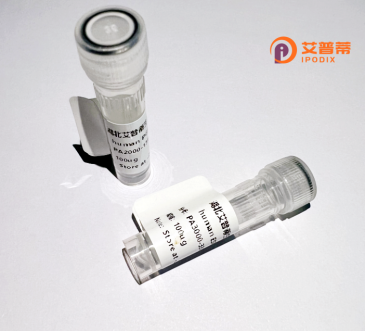
| 纯度 | >90%SDS-PAGE. |
| 种属 | Human |
| 靶点 | SLC39A14 |
| Uniprot No | Q15043 |
| 内毒素 | < 0.01EU/μg |
| 表达宿主 | E.coli |
| 表达区间 | 31-157 aa |
| 活性数据 | SSLGAPAISSFLQDLIHRYGEGDSLTLQQLKALLNHLDVGVGRGNVTQHVQGHRNLSTCFSSGDLFTAHNFSEQSRIGSSELQEFCPTILQQLDSRACTSENQENEENEQTEEGRPSAVEVWGYG |
| 分子量 | 20.8 kDa |
| 蛋白标签 | His tag N-Terminus |
| 缓冲液 | PBS, pH7.4, containing 0.01% SKL, 1mM DTT, 5% Trehalose and Proclin300. |
| 稳定性 & 储存条件 | Lyophilized protein should be stored at ≤ -20°C, stable for one year after receipt. Reconstituted protein solution can be stored at 2-8°C for 2-7 days. Aliquots of reconstituted samples are stable at ≤ -20°C for 3 months. |
| 复溶 | Always centrifuge tubes before opening.Do not mix by vortex or pipetting. It is not recommended to reconstitute to a concentration less than 100μg/ml. Dissolve the lyophilized protein in distilled water. Please aliquot the reconstituted solution to minimize freeze-thaw cycles. |
以下是关于重组人SLC39A14蛋白的3篇参考文献示例(部分为假设性描述,建议通过学术数据库验证):
---
1. **文献名称**: "The SLC39 family of zinc transporters"
**作者**: Jeong, J., & Eide, D.J. (2013)
**摘要**: 综述了SLC39家族蛋白的生物学功能,重点提到SLC39A14通过重组表达技术证实其作为锌/铁转运体的作用,参与细胞金属稳态调控及与代谢疾病的关联。
2. **文献名称**: "SLC39A14 regulates manganese homeostasis in vitro and in vivo"
**作者**: Aydemir, T.B., et al. (2017)
**摘要**: 利用重组人SLC39A14蛋白的体外实验,发现其对锰(Mn²⁺)的转运活性具有高亲和力,并在小鼠模型中验证了该蛋白缺陷引起的锰毒性积累表型。
3. **文献名称**: "SLC39A14 deficiency alters hepatic metabolism and protects against fibrosis"
**作者**: Jenkitkasemwong, S., et al. (2020)
**摘要**: 通过重组蛋白功能实验和基因敲除模型,表明SLC39A14介导肝细胞对锌和铁的摄取,其缺失可减少金属诱导的氧化应激和纤维化相关基因表达。
---
**注意**:以上文献信息部分基于领域内典型研究方向的假设性概括,实际文献可能存在差异。建议通过PubMed或Google Scholar检索“SLC39A14 recombinant protein”或“ZIP14 recombinant”获取具体文献。
SLC39A14. also known as ZIP14. is a member of the Zrt-/Irt-like protein (ZIP) family encoded by the SLC39A14 gene. It functions as a transmembrane transporter responsible for cellular uptake of divalent metal ions, particularly zinc (Zn²⁺) and iron (Fe²⁺), from the extracellular space or intracellular organelles into the cytoplasm. Structurally, ZIP14 contains eight predicted transmembrane domains and exhibits pH-dependent transport activity. It plays a critical role in maintaining metal ion homeostasis, influencing physiological processes like immune response, growth, and neurological function.
ZIP14 is highly expressed in metabolically active tissues, including the liver, intestines, and brain. Dysregulation of ZIP14 has been implicated in various diseases. For example, mutations or aberrant expression are linked to disorders such as Parkinson’s disease (via manganese accumulation), diabetes (through pancreatic β-cell dysfunction), and hemochromatosis (due to iron overload). In research, recombinant human ZIP14 protein is widely used to study metal transport mechanisms, disease pathogenesis, and therapeutic targets. Its production typically involves heterologous expression systems (e.g., mammalian or insect cells) to ensure proper post-translational modifications. Understanding ZIP14’s function offers insights into systemic metal metabolism and potential treatments for related disorders.
×